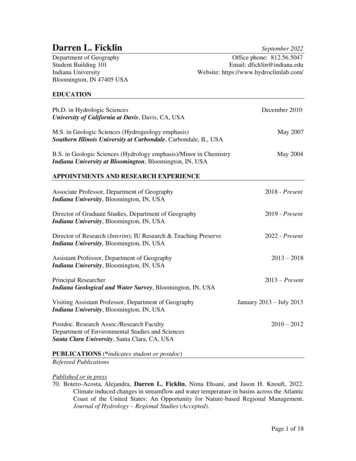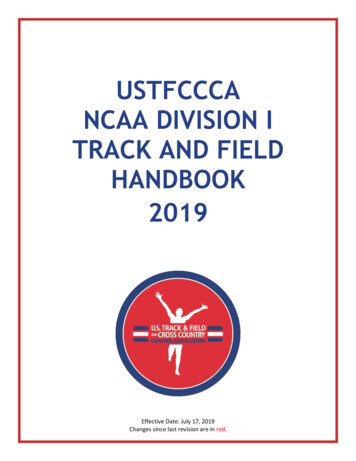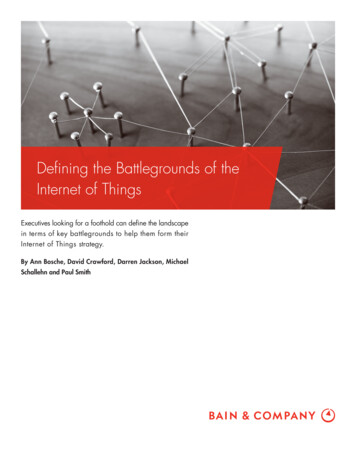
Transcription
Darren L. FicklinDepartment of GeographyStudent Building 101Indiana UniversityBloomington, IN 47405 USASeptember 2022Office phone: 812.56.5047Email: dficklin@indiana.eduWebsite: https://www.hydroclimlab.com/EDUCATIONPh.D. in Hydrologic SciencesUniversity of California at Davis, Davis, CA, USADecember 2010M.S. in Geologic Sciences (Hydrogeology emphasis)Southern Illinois University at Carbondale, Carbondale, IL, USAMay 2007B.S. in Geologic Sciences (Hydrology emphasis)/Minor in ChemistryIndiana University at Bloomington, Bloomington, IN, USAMay 2004APPOINTMENTS AND RESEARCH EXPERIENCEAssociate Professor, Department of GeographyIndiana University, Bloomington, IN, USA2018 - PresentDirector of Graduate Studies, Department of GeographyIndiana University, Bloomington, IN, USA2019 - PresentDirector of Research (Interim); IU Research & Teaching PreserveIndiana University, Bloomington, IN, USA2022 - PresentAssistant Professor, Department of GeographyIndiana University, Bloomington, IN, USAPrincipal ResearcherIndiana Geological and Water Survey, Bloomington, IN, USAVisiting Assistant Professor, Department of GeographyIndiana University, Bloomington, IN, USAPostdoc. Research Assoc./Research FacultyDepartment of Environmental Studies and SciencesSanta Clara University, Santa Clara, CA, USA2013 – 20182013 – PresentJanuary 2013 – July 20132010 – 2012PUBLICATIONS (*indicates student or postdoc)Refereed PublicationsPublished or in press70. Botero-Acosta, Alejandra, Darren L. Ficklin, Nima Ehsani, and Jason H. Knouft, 2022.Climate induced changes in streamflow and water temperature in basins across the AtlanticCoast of the United States: An Opportunity for Nature-based Regional Management.Journal of Hydrology – Regional Studies (Accepted).Page 1 of 18
69. Khodaee, Mahsa, Taehee Hwang, Darren L. Ficklin, Jonathan M. Duncan, 2022. WithWarming, Spring Streamflow Peaks are More Coupled with Vegetation Green-up thanSnowmelt in the Northeastern United States. Hydrological Processes 36(6), e14621.https://doi.org/10.1002/hyp.1462168. Ficklin, Darren L. Sarah E. Null, John T. Abatzoglou, Kimberly A. Novick, Daniel T.Myers*, 2022. Hydrological intensification will increase the complexity of water resourcemanagement. Earth’s Future 10(3), e2021EF002487.67. Novick, Kimberly A., Darren L. Ficklin, Dennis Baldocchi, Kenneth J. Davis, TeamratGhezzehei, Alexandra G. Konings, Natasha Macbean, Nina Raoult, Russell L. Scott,Yuning Shi, Benjamin N. Sulman, Jeffrey D. Wood, 2022. Confronting the Water PotentialInformation Gap. Nature Geoscience 15(3), 158-164.66. Qi, Junyu, Sangchul Lee, Xinzhong Du, Darren L. Ficklin, Qianfeng Wang, Debjani Singh,Glenn E. Moglen, Gregory W. McCarthy, Yuyu Zhou, Xuesong Zhang, Daniel T. Myers*.Coupling Terrestrial and Aquatic Thermal Processes for Improving Stream TemperatureModeling at the Watershed Scale, 2021. Journal of Hydrology 603, 126983. 5. Myers, Daniel T.*, Darren L. Ficklin, Scott M. Robeson, 2021. Incorporating rain-on-snowinto the SWAT model results in more accurate simulations of hydrologic extremes. Journalof Hydrology 603, 126972. doi: https://doi.org/10.1016/j.jhydrol.2021.12697264. Myers, Daniel T.*, Darren L. Ficklin, Scott M. Robeson, Ram P. Neupane*, Alejandra BoteroAcosta, Pedro M. Avellaneda*, 2021. Choosing an arbitrary calibration period forhydrologic models: How much does it influence water balance simulations? HydrologicalProcesses 35(2), e14045. doi: https://doi.org/10.1002/hyp.1404563. Cherkauer, Keith, A., Laura Bowling, Indrajeet Chaubey, Natalie Chin, Darren L. Ficklin,Alan F. Hamlet, Stephen Kines, Charlotte Lee, Ram Neupane*, Garett Pignotti, SanoarRahman, Sarmistha Singh, Pandara Valappil Femeena, Tanja Williamson, 2021. ClimateChange Impacts and Strategies for Adaptation for Water Resource Management in Indiana.Climatic Change 165(21).62. Hall, Damon M., Susan J. Gilbertz, Matthew B. Anderson, Pedro Avellaneda*, Darren L.Ficklin, Jason H. Knouft, Christopher S. Lowry, 2021. Mechanisms for engaging socialsystems in freshwater science research. Freshwater Science 40(1).61. Avellaneda, Pedro M.*, Darren L. Ficklin, Christopher Lowry, Jason Knouft, Damon Hall.2020. Improving hydrological models with the assimilation of crowdsourced data. WaterResources Research 56(5), e2019WR026325.60. Robeson, Scott M. Justin T. Maxwell, and Darren L. Ficklin. 2020. Bias correction ofpaleoclimatic reconstructions: A new look at 1200 years of Upper Colorado River flow.Geophysical Research Letters 47, e2019GL086689.59. Ficklin, Darren L., John T. Abatzoglou, Kimberly A. Novick. 2019. A new perspective onterrestrial hydroclimatic intensity that incorporates both supply and demand. GeophysicalResearch Letters 46, 8114-8124.58. Zhang, Quan, Darren L. Ficklin, Stefano Manzoni, Lixin Wang, Danielle Way, Richard P.Phillips, Kimberly A. Novick. 2019. Response of ecosystem intrinsic water use efficiencyand gross primary productivity to rising vapor pressure deficit. Environmental ResearchLetters 14, 074023.57. VanCompernolle, Michelle*, Jason H. Knouft, Darren L. Ficklin. 2019. Multispeciesfreshwater conservation in response to climate change in the southeastern United States.Diversity and Distributions 25, 1388-1398.56. Krause, Kevin, Huicheng Chien, Darren L. Ficklin, Damon M. Hall, Gunter A. Schuster,Todd M. Swannack, Chris A. Taylor, Jason H. Knouft. 2019 Streamflow regimes andgeologic conditions are more important than water temperature when projecting futurecrayfish distributions. Climatic Change 154(1-2), 107-123.Page 2 of 18
55. Strange, Brandon M., Justin T. Maxwell, Scott M. Robeson, Grant L. Harley, Matthew D.Therrell, Darren L. Ficklin. 2019. Comparing Three Approaches to ReconstructingStreamflow Using Tree Rings in the Wabash River Basin in the Midwestern, US. Journalof Hydrology 573, 829-840.54. VanCompernolle, Michelle*, Jason H. Knouft, Darren L. Ficklin. 2019. Hydrologic andthermal conditions occupied by a species within a single watershed predict the geographicextent of occurrence of freshwater fishes. Ecohydrology 12(3), e2071.53. Neupane, Ram P.*, Darren L. Ficklin, Jason H. Knouft, Nima Ehsani, Raj Cibin. 2019.Hydrologic responses to projected climate change in ecologically diverse watersheds of theGulf Coast, USA. International Journal of Climatology 39(4), 2227-2243.52. Giles, Nicholas, Meghna Babbar-Sebens, Raghavan Srinivasan, Darren L. Ficklin, Bradley L.Barnhart. 2019. Optimization of Linear Stream Temperature Model Parameters in the Soiland Water Assessment Tool for the Continental United States. Ecological Engineering 127,125-134.51. Kannenberg, Steven A., Justin T. Maxwell, Neil Pederson, Loïc D’Orangeville, Darren L.Ficklin, Richard P. Phillips. 2019. Drought legacies are dependent on water table depth,wood anatomy, and drought timing across the eastern U.S. Ecology Letters 22, 119-127.50. Barnhart, Bradley L., Amy Piscopo, Brenda Rashleigh, Chas Jones, Darren L. Ficklin, HeatherGolden, James Pauer, Jonathan Halama, Joseph Kasprzyk, Keith Sawicz, Michelle Simon,Nahal Hoghooghi, Paul Pettus, Paul Mayer, Robert McKane. 2018. Embedding coproduction and addressing uncertainty in watershed modeling decision-support tools:Success and challenges. Environmental Modeling and Software 109, 368-379.49. Mustafa, Mamoon, Bradley L. Barnhart, Darren L. Ficklin, Meghna Babbar-Sebens. 2018.Modeling landscape change effects on stream temperature using the Soil and WaterAssessment Tool. Water 10(9), 1143.48. Fu, Zheng, Tobias Gerken, Gabriel Bromley, Alessandro Araújo, Damien Bonal, BenoîtBurban, Darren L. Ficklin, Jose D. Fuentes, Michael Goulden, Takashi Hirano, YoshikoKosugi, Michael Liddell, Giacomo Nicolini, Shuli Niu, Olivier Roupsard, Paolo Stefani,Chunrong Mi, Zaddy Tofte, Jingfeng Xiao, Riccardo Valentini, Sebastian Wolf, Paul C.Stoy. 2018. The surface-atmosphere exchange of carbon dioxide in tropical rainforests:Sensitivity to environmental drivers and flux measurement methodology. Agricultural andForest Meteorology 263, 292-307.47. Ficklin, Darren L., John T. Abatzoglou, Scott M. Robeson, Sarah E. Null, Jason H. Knouft.2018. Natural and managed watersheds show similar responses to recent climate change.Proceedings of the National Academy of Sciences 115(34), 8553-8557.46. Du, Xinzhong, Narayan Kumar Shrestha, Darren L. Ficklin, Junye Wang. 2018. Incorporationof the equilibrium temperature approach in a Soil and Water Assessment Toolhydroclimatological stream temperature model. Hydrology and Earth System Sciences 22,2343–2357.45. Jepsen, Steven M., Thomas C. Harmon, Darren L. Ficklin, Noah P. Molotch, Bin Guan. 2018.Evapotranspiration sensitivity to air temperature across a snow-influenced watershed:Space-for-time substitution versus integrated watershed modelling. Journal of Hydrology556, 645-659.44. Maxwell, Justin T., Paul A. Knapp, Jason T. Ortegren, Darren L. Ficklin, and Peter T. Soulé.2017 Changes in the Mechanisms Causing Rapid Drought Cessation in the SoutheasternUnited States of America. Geophysical Research Letters 44(24), 12476-12483.43. Abatzoglou, John T., Darren L. Ficklin. 2017. Climatic and physiographic controls on thespatial variability in surface water balance over the contiguous United States using theBudyko framework. Water Resources Research 53(9), 7630-7643.42. Kim, Yuri, Lawrence Band, Darren L. Ficklin. 2017. Projected hydrological changes in theNorth Carolina Piedmont watershed using bias corrected North American RegionalPage 3 of 18
Climate Change Assessment Program (NARCCAP). Journal of Hydrology: RegionalStudies 12, 273-288.41. Knouft, Jason, Darren L. Ficklin. 2017. The potential impacts of climate change onbiodiversity in flowing freshwater systems. Annual Review of Ecology, Evolution, andSystematics 48, 111-133.40. Smith, Seven M., Krister Andersson, Kelsey Cody, Michael Cox, Darren L. Ficklin. 2017.Responding to a groundwater crisis: the effects of self-imposed economic incentives.Journal of Association for Environmental and Resource Economists 4, 985-1023.39. Burke, William*, Darren L. Ficklin. 2017. Future projections of streamflow magnitude andtiming differ across coastal watersheds of the western United States. International Journalof Climatology 37(13), 4493-4508.38. Barnhart, Bradley L., Keith A. Sawicz, Darren. L. Ficklin, Gerald W. Whittaker, P. Mayer.2017. MOESHA: A genetic algorithm for automatic calibration and estimation ofparameter uncertainty and sensitivity of hydrologic models. Transactions of the AmericanSociety of Agricultural and Biological Engineers 60(4), 1259-1269.37. Ficklin, Darren L., K. Novick. 2017. Historic and projected changes in vapor pressure deficitsuggest a continental-scale drying of the United States atmosphere. Journal of GeophysicalResearch – Atmospheres 122(4), 2061-2079.36. Novick, K., Darren L. Ficklin C. Williams, G. Bohrer, A.C. Oishi, L. Wang, P. Blanken, M.Litvak, A. Noormets, P. Stoy, B. Sulman, R. Phillips. 2016. The increasing importance ofatmospheric demand for ecosystem water and carbon fluxes. Nature Climate Change 6,1023-1027, DOI:10.1038/nclimate3114.35. Ayers, Jessica*, Darren L. Ficklin, Iris T. Stewart, Meredith Strunk*. 2016. Comparison ofCMIP3 and CMIP5 projected hydrologic conditions over the Upper Colorado River Basin.International Journal of Climatology 36, 3807-3818.34. Ficklin, Darren L., Scott M. Robeson, and Jason H. Knouft. 2016. Impacts of recent climatechange on trends in baseflow and stormflow in United States watersheds. GeophysicalResearch Letters 43(10), 5079-5088.33. Chen, Jinsong, Susan S. Hubbard, Kenneth H. Williams, Darren L. Ficklin. 2016. Estimatinggroundwater dynamics at a Colorado floodplain site using historical hydrologic data andclimate information. Water Resources Research 52(3), 1881-1898.32. Shawn Naylor, Sally L. Letsinger, Darren L. Ficklin, Kevin Ellett, and Greg A. Olyphant.2016. A hydropedological approach to quantifying groundwater recharge in various glacialsettings of the mid-continental U.S.A. Hydrological Processes 30(10), 1594-1608.31. Ficklin, Darren L., Sally L. Letsinger, Iris T. Stewart, Edwin P. Maurer. 2016. Assessingdifferences in snowmelt-dependent hydrologic projections using CMIP3 and CMIP5climate forcing data for the western United States. Hydrology Research 47(2), 483-500.30. Maurer, Edwin P., Darren L. Ficklin, Weile Wang. 2016. The impact of spatial scale in biascorrection of climate model output for hydrologic impact studies. Hydrology and EarthSystem Sciences 20, 685-696.29. Ficklin, Darren, L., John T. Abatzoglou, Scott M. Robeson, Anna Dufficy*. 2016. Theinfluence of climate model biases on aridity and drought projections. Journal of Climate29, 1269–1285.28. Maxwell, Justin T., Darren L. Ficklin, Grant Harley, Gregory Jones. 2016. Projecting futurewinegrape yields using a combination of Vitus vinifera growth rings and soil moisturesimulations, northern California, U.S.A. Australian Journal of Grape and Wine Research22, 73–80.27. Ficklin, Darren L, Sally L. Letsinger, Hamed Gholizadeh, Justin T. Maxwell. 2015.Incorporation of the Penman-Monteith potential evapotranspiration method into a PalmerDrought Severity Index tool. Computers & Geosciences 85, 136-141.Page 4 of 18
26. Wilmott, Cort J., Scott M. Robeson, Kenji Matsuura, Darren L. Ficklin. 2015. Assessment ofthree dimensionless measures of model performance. Environmental Modeling andSoftware 73, 167-174.25. Stewart, Iris T., Darren L. Ficklin, Carlos A. Carrillo, Russell McIntosh. 2015. 21st centuryincreases in the likelihood of extreme hydrologic conditions for the mountainous basins ofthe Southwestern U.S. Journal of Hydrology 529, 340-353.24. Mou Leong, Tan, Darren L. Ficklin, Barnali Dixon, Ab Latif Ibrahim, Zulkifli Yusop, VincentChaplot. 2015. The effects of Digital Elevation Model resolution, source, and resamplingtechnique on SWAT-simulated streamflow. Applied Geography 63, 357-368.23. Ficklin, Darren L., Justin T. Maxwell, Sally L. Letsinger, Hamed Gholizadeh. 2015. Aclimatic deconstruction of recent drought trends in the United States. EnvironmentalResearch Letters 10, 04400922. Ficklin, Darren L., Bradley L. Barnhart, Jason Knouft, Iris T. Stewart, Edwin P. Maurer, SallyL. Letsinger, Gerald W. Whittaker. 2014. Climate change and stream temperatureprojections in the Columbia River basin: habitat implications of spatial variation inhydrologic drivers. Hydrology and Earth System Sciences 18, 4897-491221. Ficklin, Darren L. and Bradley L. Barnhart. 2014. SWAT hydrologic model parameteruncertainty and its implications for hydroclimatic projections in snowmelt-dependentwatersheds. Journal of Hydrology 519, 2081-2090.20. Mou Leong, Tan, Darren L. Ficklin, Ab Latif Ibrahim, Zulkifli Yushop. 2014. Impacts anduncertainties of climate change on streamflow of the Johor River Basin, Malaysia using aCMIP5 GCM ensemble. Journal of Water and Climate Change 5(4), 676-695.19. Ficklin, Darren L., Yuzhou Luo, Minghua Zhang. 2014. The use of soil taxonomy as a soiltype identifier on the Shasta Lake watershed using SWAT. Transactions of the AmericanSociety of Agricultural and Biological Engineers 57(3), 717-728.18. Barnhart, Bradley L., Gerald W. Whittaker, Darren L. Ficklin. 2014. Improved streamtemperature simulations within SWAT using NSGA-II for automatic, multi-sitecalibration. Transactions of the American Society of Agricultural and Biological Engineers57(2), 517-530.17. Ficklin, Darren L., Iris T. Stewart, Edwin P. Maurer. 2013. Climate change impacts onstreamflow and subbasin-scale hydrology in the Colorado River Basin. PLOS ONE 8(8),e71297. DOI: 10.1371/journal.pone.007129716. Ficklin, Darren L., Yuzhou Luo, Minghua Zhang. 2013. Climate change sensitivity assessmentof streamflow and agricultural pollutant transport in California’s Central Valley using Latinhypercube sampling. Hydrological Processes 27(18), 2666-2675. DOI: 10.1002/hyp.938615. Ficklin, Darren L., Iris T. Stewart, Edwin P. Maurer. 2013. Effects of climate change on streamtemperature, dissolved oxygen, and sediment concentration in the Sierra Nevada mountainrange in California. Water Resources Research 49(5), 2765-2782.DOI:10.1002/wrcr.2024814. Luo, Yuzhou, Darren L. Ficklin, Xiaomang Liu, Minghua Zhang. 2013. Assessment of climatechange impacts on hydrology and water quality with a watershed modeling approach.Science of the Total Environment 450-451, 72-82.13. Ficklin, Darren L., Minghua Zhang. 2013. A comparison of the Curve Number and GreenAmpt Models in an Agricultural Watershed. Transactions of the American Society ofAgricultural and Biological Engineers 56 (1), 61-69.12. Ficklin, Darren L., Yuzhou Luo, Minghua Zhang. 2013. Watershed modeling of hydrologyand water quality in the Sacramento River Watershed, California. Hydrological Processes27, 236-250. DOI: 10.1002/hyp.922211. Ficklin, Darren L., Iris T. Stewart, Edwin P. Maurer. 2013. Effects of projected climate changeon the hydrology in the Mono Lake Basin, California. Climatic Change 116, 111-131. DOI:10.1007/s10584-012-0566-6Page 5 of 18
10. Luo, Yuzhou, Darren L. Ficklin, Minghua Zhang. 2012. Approaches of soil data aggregationfor hydrologic simulations. Journal of Hydrology 464-465, 467-476.9. Ficklin, Darren L., Iris T. Stewart, Edwin P. Maurer. 2012. Projections of 21st century SierraNevada local hydrology using an ensemble of General Circulation Models. Journal of theAmerican Water Resources Association 48, 1104-1125. DOI: 10.1111/j.17521688.2012.00675.x8. Wang, Zhonggen, Darren L. Ficklin, Yongyong Zhang, Minghua Zhang. 2012. Impact ofclimate change on the hydrologic cycle in the arid Shiyang River Basin. HydrologicalProcesses 26(18), 2733-2744. DOI: 10.1002/hyp.83787. Ficklin, Darren L., Yuzhou Luo, Iris T. Stewart, Edwin P. Maurer. 2012. Development andapplication of a hydroclimatological stream temperature model within the Soil and WaterAssessment Tool. Water Resources Research 48, W01511.6. Gatzke, Sarah E., Dylan E. Beaudette, Darren L. Ficklin, Yuzhou Luo, Anthony T. O’Geen,Minghua Zhang. 2011. Aggregation strategies for SSURGO data: effects on SWAT soilinputs and hydrologic outputs. Soil Science Society of America Journal 75, 1908-1921.5. Ficklin, Darren L., Eike Luedeling, Minghua Zhang. 2010. Sensitivity of groundwater rechargeto changes in climate, CO2 concentrations and canopy structure. Agricultural WaterManagement 97, 1039-1050.4. Ficklin, Darren L., Yuzhou Luo, Eike Luedeling, Sarah E. Gatzke, Minghua Zhang. 2010.Sensitivity of agricultural runoff to rising levels of CO2 and climate change in the SanJoaquin Valley watershed of California. Environmental Pollution 158, 223-234.3. Liu, Xingmei, Weiwen Zhang, Minghua Zhang, Darren L. Ficklin, Fan Wang. 2009. Spatiotemporal variations of soil nutrients influenced by an altered land tenure system in China.Geoderma 152, 23-34.2. Ficklin, Darren L., Yuzhou Luo, Eike Luedeling, Minghua Zhang. 2009. Climate changesensitivity assessment of a highly agricultural watershed using SWAT. Journal ofHydrology 347, 16-29.1. Luo, Yuzhou, Xuyang Zhang, Xingmei Liu, Darren L. Ficklin, Minghua Zhang. 2008. Dynamicmodeling of organophosphate pesticide loads in surface water in the northern San JoaquinValley watershed of California. Environmental Pollution 156, 1171-1181.Submitted/In reviewFicklin, Darren L., David M. Hannah, Niko Wanders, Stephen J. Dugdale, Judy England, JulianKlaus, Christa Kelleher. Kieran Khamis, Matthew Charlton. River temperatures in achanging, human-dominated world. (In review at Nature Water).Maxwell, Justin T., Clay Tucker, Grant L. Harley, Toudora Galuska, Darren L. Ficklin, Joshua C.Bregy, Karen J. Heeter, Tsun Fung Au, Benjamin Lockwood, Daniel J. King, R. StocktonMaxwell, Laura Smith, Emily A. Elliott, Matthew D. Therrell. 1,100-Year Reconstructionof Baseflow for the Santee River, South Carolina, USA Reveals Connection to the NorthAtlantic Subtropical High. (In review at Geophysical Research Letters).Myers, Daniel T.*, Darren L. Ficklin, Scott M. Robeson, 2022. Hydrologic implications ofprojected changes in rain-on-snow melt for Great Lakes Basin watersheds. (In review atHydrology and Earth System Sciences).Chang, Qing, Darren L. Ficklin, Wenzhe Jiao, Sander O. Denham, Jeffrey D. Wood, NathanielA. Brunsell, Roser Matamala, David R. Cook, Lixin Wang, Kimberly A. Novick, 2022.The importance of phenology and eco-physiological function in detecting plant droughtstress. (In review at Earth’s Future)Ficklin, Darren L., Christa Kelleher, Ellen Bergan*, Daniel T. Myers*, Seth Adelsperger*, ErinHardman*, 2022. Influence of the 2021 Brood X cicada emergence on soil water infiltrationrates in the midwestern United States. (In review at Hydrological Processes)Page 6 of 18
ThesesFicklin, Darren. Modeling the impacts of climate change on hydrology and agricultural pollutantrunoff in California’s Central Valley. Ph.D. Dissertation, University of California at Davis,2010.Ficklin, Darren. Hydrogeologic setting, water budget, and analysis of groundwater exchange atCrystal Lake, a glacial lake in McHenry County, Illinois. M.S. Thesis, Southern IllinoisUniversity at Carbondale, 2007.FUNDED RESEARCH AND TEACHING ACTIVITIESResearch – Funded United States Geological Survey: Future of Aquatic Flows (2022-2024) -- Exploringchanges in rain-on-snow events and their influence on future streamflows, streamtemperatures, and management priorities in the Great Lakes Basin. Role: PI with Co-PIsJason Knouft (Saint Louis University) and Karen Murchie (John G. Shedd Aquarium);Total amount: 316,185 ( 302,435 to IU). National Science Foundation: Hydrologic Sciences (2021-2022) -- RAPID: Influence ofthe Brood X Cicada Emergence on Soil Water Infiltration. Role: PI; Total amount 19,331. National Science Foundation: Advances in Biological Informatics (2017-2021) -Collaborative Research: ABI Innovation: Improving high performance super computeraquatic ecosystem models with the integration of real-time citizen science data – Role: PIwith Co-PIs Christopher Lowry (University at Buffalo), Jason Knouft (Saint LouisUniversity) and Damon Hall (Saint Louis University); Total amount: 510,282; IU portion: 384,948. National Science Foundation: Advances in Biological Informatics (2016-2022) -Collaborative Research: ABI Development: HydroClim: Empowering aquatic research inNorth America with data from high-resolution streamflow and water temperature GISmodeling – Role: Co-PI with PI Jason Knouft and Co-PIs Henry Bart (Tulane University)and Nelson Rios (Tulane University); Total amount: 1,667,976; IU portion: 623,272. U.S. Army Corps of Engineers: Great Rivers Cooperative Ecosystems Studies Unit(2015-2017) -- Integrating hydrodynamic, GIS, and ecological models to develop multiscale tools that can predict the dynamics of the spatial distributions of threatened andendangered species throughout the waterways of the United States – Role: PI with JasonKnouft (Saint Louis University) and Damon Hall (Saint Louis University); Total amount: 80,163; IU portion: 80,163. Kearney Mission on Spatial and Temporal Scaling -- University of California, Davis -Development of soil property aggregation techniques for spatially distributed watershedmodels. University of California, Davis – Role: Co-PI -- 88,000Teaching – Funded Indiana University Sustainability Course Development Fellowship -- Water securityand sustainability: A socio-ecological perspective – with Dr. Majed Akhter -- 6,000Research – Submitted National Science Foundation: Hydrologic Sciences – Collaborative Research: Exploringthe Influence of Agricultural Tile Drainage on Streamflow and Water Temperature in theMidwestern US using a Stakeholder-driven Approach. Role: PI with PI Damon Hall(University of Missouri); Total amount: 574,505 ( 300,236 to IU).Page 7 of 18
AWARDS Indiana University Trustees Teaching Award (2022). 2,500.University of Birmingham (UK) Institute of Advanced Studies Vanguard Fellowship(May-June 2022).Outstanding Junior Faculty Award (2018), Indiana University Bloomington. 15,000.Campus Catalyst Sustainability Award for Excellence in Research (2016), IndianaUniversity Office of SustainabilityPRESENTATIONSInvited presentations (* indicates student or postdoc)Ficklin, Darren L., Ellen V. Bergan, Erin M. Hardman, Seth R. Adelsperger, Daniel T. Myers.2022. Influence of the 2021 Brood X cicada emergence on soil water infiltration rates inthe midwestern United States. Department of Earth Sciences, Indiana University-PurdueUniversity Indianapolis, Indianapolis, IN, USAFicklin, Darren L., Engaging local communities to advance hydrologic research. 2022. TheInstitute of Advanced Studies. University of Birmingham. Birmingham, UK.Ficklin, Darren L., Ellen V. Bergan, Erin M. Hardman, Seth R. Adelsperger, Daniel T. Myers.2022. Influence of the 2021 Brood X cicada emergence on soil water infiltration rates inthe midwestern United States. Indiana University O’Neill School of Public andEnvironmental Affairs Environmental Science Colloquium. Bloomington, Indiana.Ficklin, Darren L., Pedro Avellaneda, Christopher Lowry, Jason Knouft, Damon Hall. 2020.Using local communities to drive hydrologic forecasting. Department of EnvironmentalSciences Winter Seminar Series. University of California-Riverside.Ficklin, Darren L., Pedro Avellaneda* Christopher Lowry, Jason Knouft, Damon Hall. 2020.Hydrology of the people, by the people, for the people: bringing together citizen scienceand hydrologic forecasting. Hydrologic Sciences and Water Resources EngineeringSeminar Series. University of Colorado-Boulder.Ficklin, Darren L., Pedro Avellaneda*, Christopher Lowry, Jason Knouft, Damon Hall. 2019.Improving hydrological models with the assimilation of citizen science data. University atBuffalo Department of Geology Fall 2019 Pegrum Lecture Series.Ficklin, Darren L. 2018. Recent trends in streamflow throughout the United States. University ofCincinnati Department of Chemical and Environmental Engineering Spring Seminar.Ficklin, Darren L., John T. Abatzoglou, Jason Knouft, Scott M. Robeson. 2017. Recent trends inecologically-relevant streamflows in North America. American Geophysical Union FallMeeting. New Orleans, Louisiana.Ficklin, Darren L. 2017. The past, present, and future of western United States hydroclimate.Keynote Speaker for the 2017 Crossroads Geology Conference at Indiana University.Bloomington, Indiana.Ficklin, Darren L., John T. Abatzoglou, Scott M. Robeson, Anna Dufficy*. 2015. How do biasesin General Circulation Models affect projections of aridity and drought? AmericanGeophysical Union Fall Meeting. San Francisco, California.Ficklin, Darren L., Justin T. Maxwell, Sally L. Letsinger, Hamed Gholizadeh. 2015. A climaticdeconstruction of recent drought trends in the United States. Indiana University School ofPublic and Environmental Affairs Environmental Science Colloquium. Bloomington,Indiana.Ficklin, Darren L. 2014. General Circulation Models: downscaling and incorporation intowatershed models. American Society of Agronomy, Crop Science Society of America, andthe Soil Science Society of America Joint Annual Meeting. Long Beach, California.Page 8 of 18
Ficklin, Darren L. 2014. Implications of a changing climate on water resources in the westernUnited States. Clean Water Matters: Challenges and Research Perspectives Workshop.Beijing, China.Ficklin, Darren L, Iris T. Stewart, Edwin P. Maurer. 2012. Effects of climate change on hydrologyand stream temperature in the Merced and Tuolumne River watersheds. YosemiteHydroclimate Meeting. Yosemite, California.Ficklin, Darren L., Iris T. Stewart, Edwin P. Maurer. 2011. Effects of projected climate changeon the hydrology in the Mono Lake Basin, California. UC Davis Hydrologic SciencesSeminar Series. Davis, CAOther presentations (* indicates student or postdoc)Myers, Daniel T., David Jones, Darren L. Ficklin, John Paul Schmit, 2022. How do Water QualityModels Respond to Growing vs. Non-growing Season Landuse Inputs? An Explorationwith Google Earth Engine and Dynamic World. American Geophysical Union FallMeeting. Chicago, Illinois.Ficklin, Darren L., David M. Hannah, Niko Wanders, Stephen J. Dugdale, Judy England, JulianKlaus, Christa Kelleher, 2022. The importance of understanding river temperatures in ahuman-dominated world. American Geophysical Union Fall Meeting. Chicago, Illinois.Adelsperger, Seth R.* and Darren L Ficklin, 2022. Draining the Upper Midwest: Changes inWater Yield due to Agricultural Tiling. American Geophysical Union Fall Meeting.Chicago, Illinois.Adelsperger, Seth R.*, Darren L Ficklin, Scott M Robeson, and Sally L Letsinger, 2022. TemporalVariability of Water Yield in Watersheds Overlying the Ogallala Aquifer due toPrecipitation, Potential Evapotranspiration, and Irrigation. American Geophysical UnionFrontiers in Hydrology Meeting. San Juan, Puerto Rico.Khodaee, Mahsa, Taehee Hwang, Darren L Ficklin, and Jonathan M Duncan, 2022. Withwarming, spring streamflow peaks are more coupled with vegetation green-up thansnowmelt in the northeastern United States. American Geophysical Union Frontiers inHydrology Meeting. San Juan, Puerto Rico.Novick, Kimberly, Sander Denham, Qing Chang, Mitch Korolev, Mallory Barnes, Darren L.Ficklin, 2022. Phenology-driven variation in evapotranspiration: implications for earlydrought monitoring and detection Ecological Society of American Annual Meeting.Montréal, Québec, CanadaNovick, Kimberly A., Darren L. Ficklin, Dennis Baldocchi, Kenneth J. Davis, Teamrat Ghezzehei,Alexandra G. Konings, Natasha MacBean, Nina Raoult, Russell L. Scott, Yuning Shi,Benjamin N. Sulman, Jeffrey D. Wood, 2022. Confronting the Water Potential InformationGap. European Geophysical Union Fall Meeting. Vienna, Austria.Wang, Xiaojun, Jason Knouft, Darren L. Ficklin, Nelson Rios, Henry Bart, 2021. HydroClim DataPortal: Cyberinfrastructure for providing high-resolution GIS modeled streamflow andwater temperature data to researchers. Virtua
Page 2 of 18 69. Khodaee, Mahsa, Taehee Hwang, Darren L. Ficklin, Jonathan M. Duncan, 2022. With Warming, Spring Streamflow Peaks are More Coupled with Vegetation Green-up than










